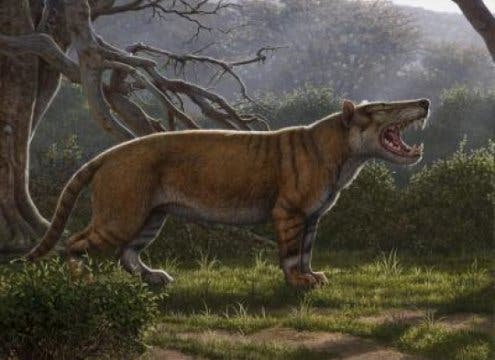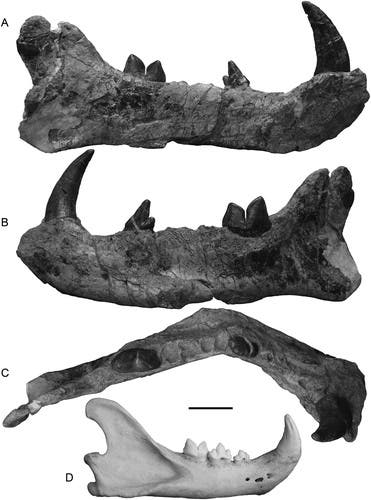Ohio University paleontologists have discovered a new species of extinct carnivore. Its lineage has been severed by the ages but, while it was alive, this massive predator was likely the terror of the eastern stretches of Africa.

Illustration by Mauricio Anton.
Larger than any big cat today — larger, in fact, than a polar bear — with a skull as large as that of a rhinoceros and dagger-long canine teeth, Simbakubwa kutokaafrika was a really scary part of the ecosystems occupied by early apes and monkeys 22 million years ago. The species is described in a new paper published by paleontologists from the University of Ohio based on most of its jaw, portions of its skull, and parts of its skeleton.
Drawer predator
“Opening a museum drawer, we saw a row of gigantic meat-eating teeth, clearly belonging to a species new to science,” says study lead author Dr. Matthew Borths, who is currently the Curator of the Division of Fossil Primates at the Duke Lemur Center at Duke University.
The fossils used in this study aren’t exactly freshly-recovered. They were unearthed in Kenya decades ago by teams looking for ancient ape fossils. Simbakubwa’s fossils were placed in a drawer at the National Museums of Kenya for safekeeping and then kind of… forgotten about. Borths, alongside his Ohio University colleague Dr. Nancy Stevens recognized the significance of the fossils and set about analyzing them properly.
Simbakubwa is Swahili for “big lion”, because the animal was likely at the top of the food chain in Africa, as lions are in modern African ecosystems. The species name, kutokaafrika, is Swahili for “coming from Africa”. Yet Simbakubwa is not closely related to big cats or any other mammalian carnivore alive today. It is the oldest of the gigantic hyaenodonts. Hyaenodonts were a lineage of giant carnivores likely originated on the African continent which moved northward to flourish for millions of years.

Image credits Matthew Borths, Nancy Stevens, (2019), JoVP.
They were the first mammalian carnivores in Africa, the team explains. For roughly 45 million years after non-avian dinosaurs disappeared, they were also the apex predators of the continent. After millions of years of near-isolation, however, Africa drifted into contact with the northern continents, enabling flora and fauna to exchange between these (previously-isolated) landmasses.
Around this time, the relatives of cats, hyenas, and dogs began to arrive in Africa from Eurasia. Meanwhile, Simbakubwa’s kin was making their way north. This would not prove to be a very savvy decision — in time, hyaenodonts worldwide went extinct.
“It’s a fascinating time in biological history,” Borths says. “Lineages that had never encountered each other begin to appear together in the fossil record.”
“We don’t know exactly what drove hyaenodonts to extinction, but ecosystems were changing quickly as the global climate became drier. The gigantic relatives of Simbakubwa were among the last hyaenodonts on the planet,” he adds.
The paper “Simbakubwa kutokaafrika, gen. et sp. nov. (Hyainailourinae, Hyaenodonta, ‘Creodonta,’ Mammalia), a gigantic carnivore from the earliest Miocene of Kenya” has been published in the Journal of Vertebrate Paleontology.






